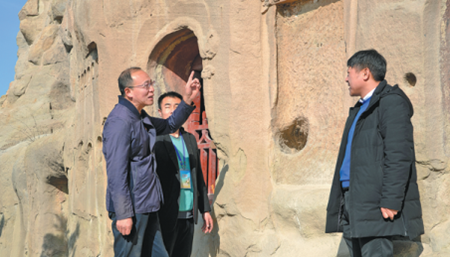
Yu Hao (first from left) discusses cultural relics protection with his colleagues in the Tianlong Mountain grottoes in Taiyuan, Shanxi province. [Photo/China Daily]
That year the museum signed a deal with the University of Chicago's Center for the Art of East Asia to help "more people appreciate the lost beauty of the mountain".
Ever since, 27 museums in nine countries, where 108 stolen relics from the grottoes are now stored, have consented to provide Yu's museum with three dimensional scan data of the pieces.
With the central government's help, the museum exhibited more than 100 virtual Buddha statues restored using digital technology through the project Yu initiated in Saint-Denis, a commune in the northern suburbs of Paris; it attracted about seven thousand visitors in two months.
"The digital exhibition of Tianlong Mountain grottoes in France has created a new model for showcasing Chinese culture. It is encouraging for us," says Wu Junhua, a researcher at the Shanxi Provincial Cultural Heritage Administration.
The exhibition moved to Taiyuan in September. "I had never thought that technology could help protect cultural relics," said Fu Xiaoying, an impressed local visitor. "Technology has not only helped bring out the beauty of the relics from the grottoes, but also instilled them with vitality."
The Tianlong Mountain grottoes are where the arts, religion and nature merge. "They are also witness to the humiliation and perseverance of China's recent history," said Yu. "I hope more people can see that beyond the ruins in the mountains."
